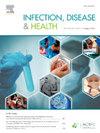The application of environmental health assessment strategies to detect Streptococcus pyogenes in Kimberley school classrooms
IF 2
Q2 PUBLIC, ENVIRONMENTAL & OCCUPATIONAL HEALTH
引用次数: 0
Abstract
Background
Children spend almost one-third of their waking hours at school. Streptococcus pyogenes (Strep A) is a common childhood bacterial infection that can progress to causing serious disease. We aimed to detect Strep A in classrooms by using environmental settle plates and swabbing of high-touch surfaces in two remote schools in the Kimberley, Western Australia.
Methods
Twelve classrooms in two schools participated in 2021 and 2022. Seven horse-blood agar plates containing colistin and nalidixic acid (HBA-CNA) were placed in each occupied classroom at varied heights for 4 h, and 20 high-touch items were swabbed and later cultured on HBA-CNA plates. The primary outcome of each sample was presence or absence of Strep A. Identified Strep A isolates were whole genome sequenced (WGS) to assess for similarity between host-derived and environmental strains.
Results
During two visits to each participating Kimberley school in June 2021 and September 2022, the point prevalence of Strep A positive throat swab ranged between 3/34 (8.8 %) and 5/21 (23.8 %); Strep A impetigo was lower at between 0/43 (0 %) and 2/23 (8.7 %). Strep A was detected from 4/240 (2 %) environmental swabs collected across 3/12 (25 %) classrooms but not cultured from any of the classroom settle plates. Whole genome sequencing identified environmental emm types to also be those strains in circulation.
Conclusions
There was little evidence to support fomite, droplet or airborne Strep A in classrooms as major modes of transmission among children. Further work is required to determine if classrooms play a role in the transmission of Strep A between students.
应用环境健康评估策略检测金伯利学校教室中的化脓性链球菌。
背景:孩子们醒着的时间几乎有三分之一是在学校度过的。化脓性链球菌(链球菌A)是一种常见的儿童细菌感染,可以发展成严重的疾病。我们的目标是通过在西澳大利亚金伯利的两所偏远学校使用环境检测板和擦拭高接触表面来检测教室中的链球菌A。方法:分别于2021年和2022年参与两所学校的12个教室。将7个含有粘菌素和萘啶酸(HBA-CNA)的马血琼脂板放置在每个占用的教室不同高度上4小时,并擦拭20个高接触项目,然后在HBA-CNA板上培养。每个样本的主要结果是存在或不存在链球菌A。鉴定出的链球菌A分离株进行全基因组测序(WGS),以评估宿主衍生菌株和环境菌株之间的相似性。结果:在2021年6月和2022年9月对每个金伯利参与学校进行两次访问时,链球菌A阳性咽拭子点患病率在3/34(8.8%)和5/21(23.8%)之间;A链球菌脓疱疮较低,在0/43(0%)和2/23(8.7%)之间。在3/12间教室(25%)收集的4/240份(2%)环境拭子中检测到链球菌A,但在任何教室沉淀板中均未检测到链球菌A。全基因组测序鉴定出环境型emm也是那些在流通的菌株。结论:几乎没有证据支持教室中污染物、飞沫或空气传播的甲型链球菌是儿童传播的主要方式。需要进一步的工作来确定教室是否在学生之间传播甲型链球菌中起作用。
本文章由计算机程序翻译,如有差异,请以英文原文为准。
求助全文
约1分钟内获得全文
求助全文
来源期刊

Infection Disease & Health
PUBLIC, ENVIRONMENTAL & OCCUPATIONAL HEALTH-
CiteScore
5.70
自引率
5.70%
发文量
40
审稿时长
20 days
期刊介绍:
The journal aims to be a platform for the publication and dissemination of knowledge in the area of infection and disease causing infection in humans. The journal is quarterly and publishes research, reviews, concise communications, commentary and other articles concerned with infection and disease affecting the health of an individual, organisation or population. The original and important articles in the journal investigate, report or discuss infection prevention and control; clinical, social, epidemiological or public health aspects of infectious disease; policy and planning for the control of infections; zoonoses; and vaccination related to disease in human health. Infection, Disease & Health provides a platform for the publication and dissemination of original knowledge at the nexus of the areas infection, Disease and health in a One Health context. One Health recognizes that the health of people is connected to the health of animals and the environment. One Health encourages and advances the collaborative efforts of multiple disciplines-working locally, nationally, and globally-to achieve the best health for people, animals, and our environment. This approach is fundamental because 6 out of every 10 infectious diseases in humans are zoonotic, or spread from animals. We would be expected to report or discuss infection prevention and control; clinical, social, epidemiological or public health aspects of infectious disease; policy and planning for the control of infections; zoonosis; and vaccination related to disease in human health. The Journal seeks to bring together knowledge from all specialties involved in infection research and clinical practice, and present the best work in this ever-changing field. The audience of the journal includes researchers, clinicians, health workers and public policy professionals concerned with infection, disease and health.
 求助内容:
求助内容: 应助结果提醒方式:
应助结果提醒方式:


